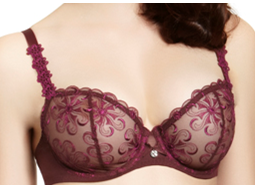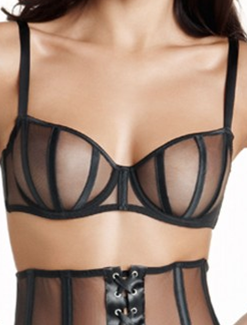Hey all.
A couple of lovely comments have gone into feedback instead of appearing as comments, meaning I can’t approve them and get them to actually show up on the blog. This is due to an error I made in formatting my first posts. Your comments are awesome! I don’t hate you! I just messed up with WordPress! But I know how not to make that happen now (I think). Bear with my newbie pathos, please. I am getting my ducks in a row, slowly.
One of those unapprovable comments asked a question about Parfait by Affinitas — a brand that’s newly close to my heart, literally and figuratively: I am wearing a new Charlotte as I type. Of which more anon. But the question asked here was rather interesting and was really more abstract and less brand-specific: Do I consider Parfait a full-bust brand, given that only three of its bras go past a G cup?
Okay. Here’s the thing about defining full-bust brands.
In a perfect world, every full-bust brand would be like Freya, or better yet like Cleo/Panache, or better yet like Ewa Michalak. That is, they would all cover a cup range more or less congruent with the reality of actual women’s body diversity. All styles, including an appropriate diverse range of shapes other than fullcup — balconettes, halfcups, plunges, etc, all of which would be modified if technically necessary, not just dropped — would be offered in cups out to K or KK, and serious players would offer an option to custom-order cup sizes beyond that.
I wrote a stop at K-KK into that sentence somewhat arbitrarily, because I don’t have the rigorous quantitative population data I’d need to be able to place the bell curve accurately. My point is not that there aren’t natural breasts that need a higher cup size. Nor, for that matter, that women with very large implants don’t deserve nice bras that fit. But I don’t think that there’s a business model that will allow you to cater for 100% of women in routine manufacturing. You’re going to have to draw the line somewhere short of the furthest outliers, and there’s going to be a few percent of customers left doing special orders or served by just a couple of niche specialty brands. Of course, the error of the lingerie market at large has been to consider everyone over a C cup or an F cup or whatever a vanishingly rare outlier to be served only by the odd niche specialty brand, which as we all know is absolutely preposterous. But as you build awareness, as you expand the spectrum of sizes acknowledged as not-rare, as you move up the spectrum to push the goalposts out further and further, the preposterousness coefficient drops. Eventually, you are going to run into a legitimate outlier barrier, one that effectively puts a ceiling on size range for your brand’s business model.
Plus: the full-bust market is not only larger than is well understood by most of the industry to date, it’s also more complex. Different parts of it can have significantly different needs on the technical side. One brand’s forte may not be another’s. We see already in the major UK brands today, for instance, that Freya’s greatest strength is probably D-G, though they do go higher, and that Panache does a lot of its best work in G-K, though they do go lower. Likewise, there are brands better for the wide and shallow and others (not enough, in higher cups!) better for the narrow and projected. I don’t need every brand to understand and address every set of problems equally well. I do expect the large category-leading houses like Eveden (Wacoal) and Panache to cater to the entire category, but not necessarily to cater to all of it with the same bra, or even with the same brand.
So in the world we actually live in, I’m a little more lenient. Some of you may prefer to rephrase that as “florid and permissive,” even. But it’s not about the ideology. It’s about the objective. Serving the full-bust market better is a goal that I very much want to encourage bra makers to set themselves more often, more seriously, more routinely. I can’t do that if I set myself up as a purist, sneering and pointing the finger of scorn at the wretched inadequacy of brands pathetic enough to aspire to serve only the DD-G range. Sure, it’s inadequate, given what the full-bust marketplace actually looks like, but progress needs to start somewhere. The DD-G range is effectively the entry level. It’s the low-hanging fruit for a brand that’s considering whether, maybe, it ought to think about starting to do something about serving more full-busted women. It’s going to be much easier for lingerie brands to get their heads around that first bite — “hey, DD-G cups really aren’t that big or rare, I think there could be a market for us” — than to swallow the whole enchilada of reality in a single gargantuan mouthful. Besides the cultural biases to be transcended, there are technical challenges that come with very large cups on smaller bands, and you can’t expect a company that’s new to full-bust to have Panache’s or some of the Polish brands’ seasoned and versatile engineering resources right out of the box. That’s a lot of barriers to entry to expect a brand to negotiate all at once. Once proof of principle — i.e., demand and profitability — is established in the lower full-bust range, I expect demand to rise at the higher end and make the further magnitude of opportunity clear. That should encourage additional range and brand expansions. But you want to start with the first domino in the series.
Accordingly, I count any brand that goes up to a UK G cup in core styles as a full-bust brand. I say core styles because I don’t count throwing the OMG Big Girls a nasty orthopedic-minimizer bone as qualifying for entry. If most of the brand is in A-F and beautifully designed, and then there’s a couple of apologetic frumpy consolation-prize minimizing fullcup versions offered in G? You lose; you get nothing; good day, sir.
But I wholeheartedly applaud brands like Simone Perele. Till not long ago, Simone Perele went only to a European F cup, and did not qualify to my mind as a full-bust player. That changed recently when it made the effort to expand certain styles, including the Revelation demi, below, as far as a G cup:

Simone Perele – Revelation: this sheer vertically seamed half-cup is a pretty ballsy full-bust foray
That’s a European G, of course. But Simone Perele’s size grading runs big at the upper end, a bit like Prima Donna’s, and I have a 32G that’s pretty true cup-wise. And really, an honest-to-God sheer vertically seamed halfcup like the Revelation is commendably fearless and aggressive for such an early move into full-bust. Plenty of brands that routinely provide G and occasional GG cups in their fullcup styles will wimp out on this particular challenge and tell you, so sorry, madame, it can’t be done in anything over an F. (I’m looking at you, Fauve, you fools, with your goddamn Chloe which you refuse to provide to me in its breathtaking halfcup variant that I would buy every color in mumble sputter.)
TL;DR I like that Simone Perele is doing this. I like it a lot. They deserve praise for getting this far. Not censure for not making it further.
I would also like to encourage them for the love of God to please bring out some bigger cup sizes in their boudoir Implicite line. Because dear God in heaven what price would I not pay for this bra in my size:
But the point is, credit where credit is due, as well as impassioned pleas for more — yes?
